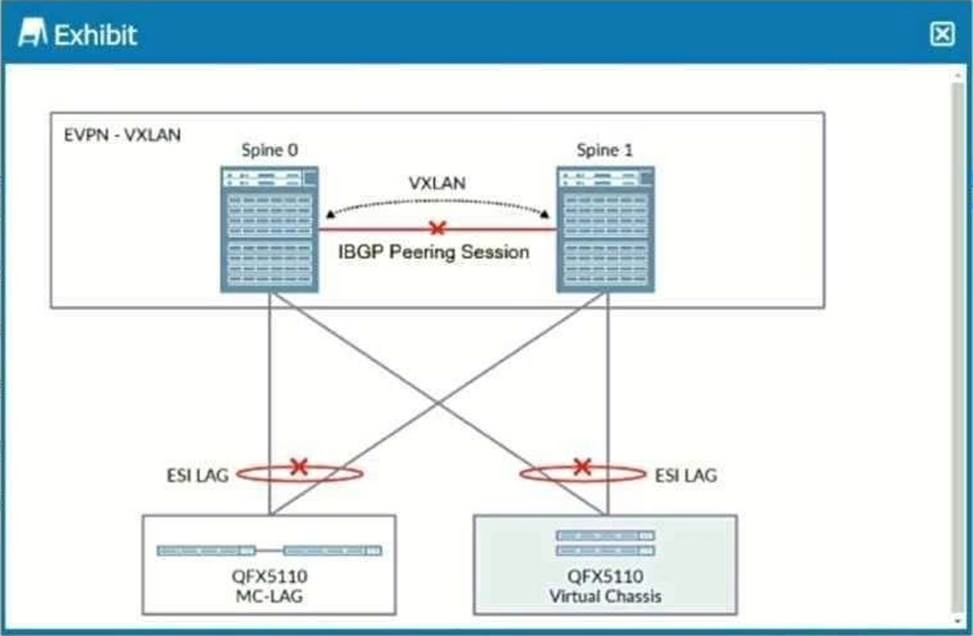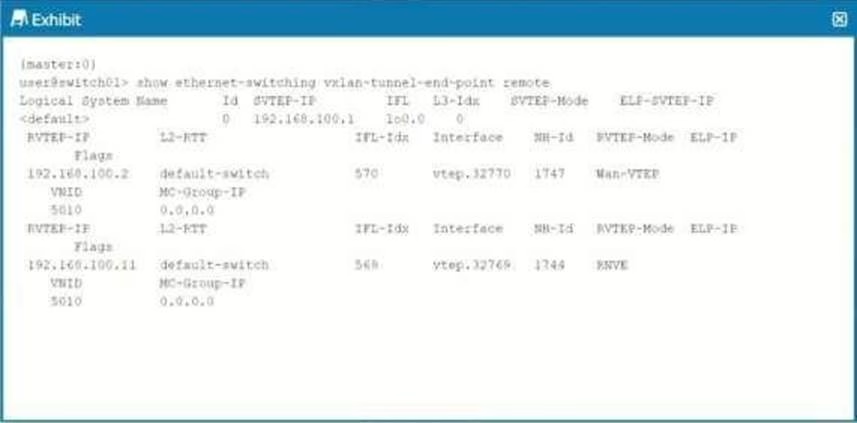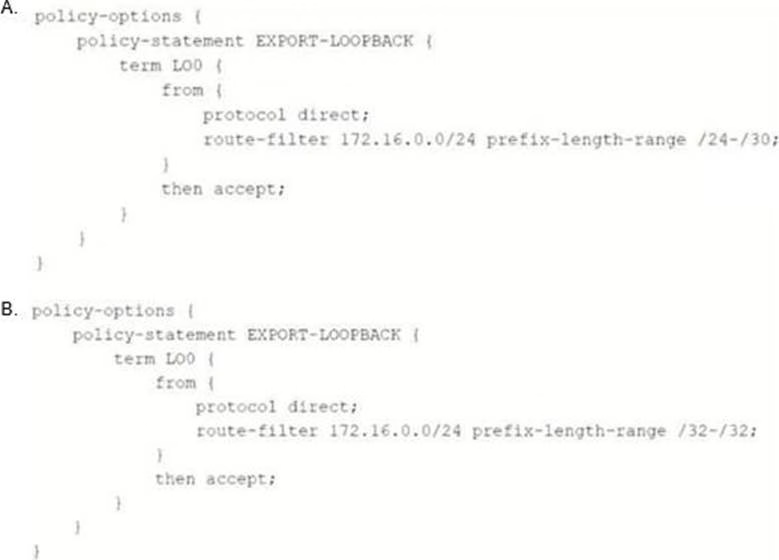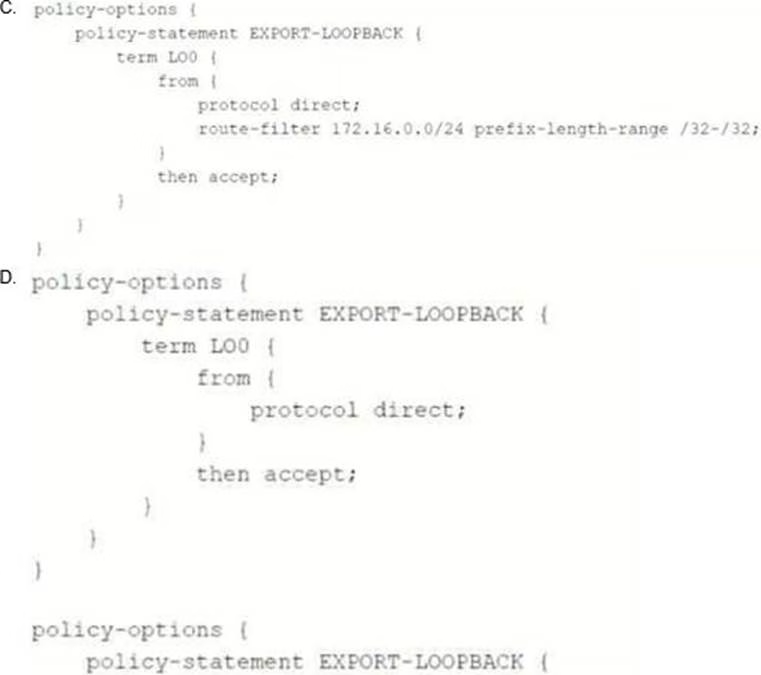Juniper JN0-682 Data Center, Professional (JNCIP-DC) Online Training
Juniper JN0-682 Online Training
The questions for JN0-682 were last updated at Dec 14,2025.
- Exam Code: JN0-682
- Exam Name: Data Center, Professional (JNCIP-DC)
- Certification Provider: Juniper
- Latest update: Dec 14,2025
Referring to the exhibit.

You have a data center in which only the spine devices are using EVPN and VXLAN. The leaf nodes are multihomed in active-active mode to the spine nodes through ESI LAG interfaces. In this design, a link failure on the interface connecting the spine nodes would also cause all traffic from the spine to the leaf nodes to drop.
In this scenario, which command configured on which nodes would solve this problem?
- A . the disable protocols evpn no-core-isolation command on the spine nodes
- B . the set protocols evpn no-core-isolation command on the spine nodes
- C . the disable protocols evpn no-core-isolation command on the leaf nodes
- D . the set protocols evpn no-core-isolation command on the leaf nodes
You are evaluating which method to use for learning MAC addresses in your VXLAN network.
Which statement is true in this scenario?
- A . Multicast exchanges MAC addresses through data plane learning and is more reliable than EVPN.
- B . EVPN exchanges MAC addresses through control plane learning and is more reliable than multicast.
- C . EVPN exchanges MAC addresses through data plane learning and is more reliable than multicast.
- D . Multicast exchanges MAC addresses through control plane learning and is not more reliable than EVPN.
Referring to the exhibit, which two statements are correct? (Choose two.)

- A . Seamless EVPN VXLAN stitching is in use.
- B . Switch01 is a spine device.
- C . An OTT data center interconnect is in use.
- D . Switch01 is a leaf device.
You are asked to implement a monitoring and telemetry solution for the QFX Series devices in
your IP fabric that uses a push model to collect both system event data and statistical data for your QFX Series devices.
Which technology satisfies your requirements?
- A . JunosXMLAPI
- B . REST API
- C . SNMP
- D . Junos Telemetry Interface
You are configuring an MX Series router to act as a Layer 3 gateway to route traffic between VXLANs in different data centers across a WAN connection.
In this scenario, what must you do to enable this communication?
- A . Configure route reflectors.
- B . Change the UDP port used by the VXLANs.
- C . Configure the IRB interfaces to connect the VXLANs.
- D . Enable PIM on all interfaces.
You are deploying a switch using ZTP.
Which two statements are true in this scenario? (Choose two.)
- A . If the switch is already running the referenced image, no action is performed and the switch
moves to the next ZTP step in the ZTP process. - B . Using DHCP Option 150. the DHCP server informs the switch of a software image name.
- C . Using DHCP Option 43 sub option 01, the DHCP server informs the switch of the configuration file name.
- D . If no configuration file is referenced in DHCP Options, the switch downloads a default configuration file from the storage server.
You are asked to build a single export policy that can be applied to all devices to advertise only loopback IP addresses in the 172.16.0.0/24 subnet into your EBGP IP fabric.
In this scenario, which two solutions would accomplish this task? (Choose two.)


- A . Option A
- B . Option B
- C . Option C
- D . Option D
When considering VRF routing-instances for network segmentation, which two statements are true? (Choose two.)
- A . A logical interface can participate in multiple VRFs.
- B . Multiple VRFs on a single device consolidate routing information to a single table.
- C . VRFs have independent routing tables.
- D . VRFs support overlapping subnets.
What are two types of EVPN routes? (Choose two.)
- A . ES-lmport route target
- B . Ethernet segment
- C . MAC mobility
- D . MAC advertisement
You are considering deploying a MAC-VRF type routing instance with a VLAN-bundle service type. In this scenario, which two statements are correct? (Choose two.)
- A . It can be implemented in a bridge overlay architecture.
- B . VLAN normalization is supported.
- C . Multiple VLAN IDs per EVI are supported.
- D . It can be implemented in an ERB architecture.
Latest JN0-682 Dumps Valid Version with 65 Q&As
Latest And Valid Q&A | Instant Download | Once Fail, Full Refund

